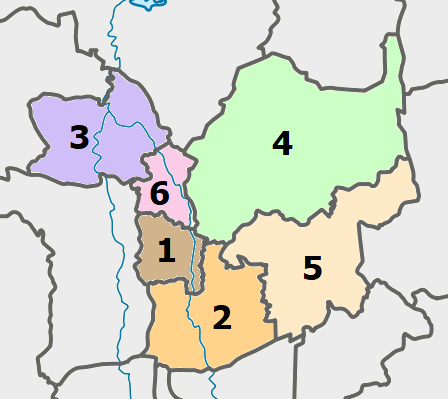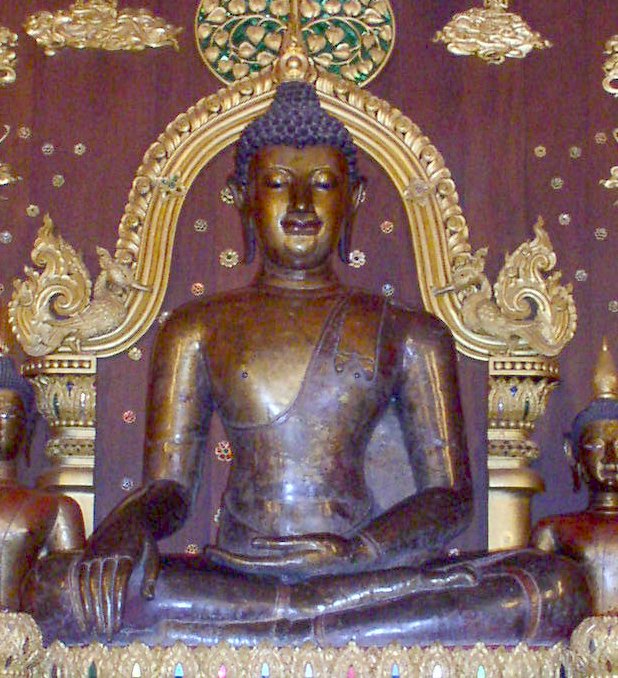|
Wat Bang Oi Chang
Wat Bang Oi Chang ( th, วัดบางอ้อยช้าง, ) is an ancient temple is located rim Khlong Bangkok Noi in the area of Bang Kruai District, Nonthaburi Province, on the Bangkok Metropolitan Region, outskirts of Bangkok. Its name meaning "place of canes for elephants temple". Because its location are the communities whose duties used to supply elephant food, normally sugar-canes and other plants to the royal elephants during Ayutthaya period. In addition, it was a place where densely grown Lannea coromandelica, wodier trees (Oi Chang in Thai) sprouts, hence the name "Bang Oi Chang". At that time, people used the wodier tree bark for elephants. They pounded the bark until soft. The soft bark was then put over the backs of each battle elephant, beneath the howdah. It helped protect the elephant's skin from rubbing directly against the seat. This temple is assumed to have been built in the late Ayutthaya period around 1761 by local people. During the war with Bur ... [...More Info...] [...Related Items...] OR: [Wikipedia] [Google] [Baidu] |
Central Thailand
Central Thailand (Central plain) or more specifically Siam (also known as Suvarnabhumi and Dvaravati) is one of the regions of Thailand, covering the broad alluvial plain of the Chao Phraya River. It is separated from northeast Thailand (Isan) by the Phetchabun mountain range. The Tenasserim Hills separate it from Myanmar to the west. In the north it is bounded by the Phi Pan Nam Range, one of the hilly systems of northern Thailand. The area was the heartland of the Ayutthaya Kingdom (at times referred to as Siam), and is still the dominant area of Thailand, containing as it does, the world's most primate city, Bangkok. Definition The grouping of Thai provinces into regions follow two major systems, in which Thailand is divided into either four or six regions. In the six-region system, commonly used in geographical studies, central Thailand extends from Sukhothai and Phitsanulok Provinces in the north to the provinces bordering the Gulf of Thailand in the south, excluding the m ... [...More Info...] [...Related Items...] OR: [Wikipedia] [Google] [Baidu] |
Sunthon Phu
Phra Sunthorn Vohara (Phu) ( th, พระสุนทรโวหาร (ภู่), , ; 26 June 1786 – 1855), known as Sunthorn Phu ( th, สุนทรภู่, , ), is Thailand's best-known royal poet. He wrote during the Rattanakosin period. Phu's career as a royal poet began in the reign of King Rama II, and when the king died, he resigned from the role and became a monk. Twenty years later, in the reign of King Rama III, he returned to court as a royal scribe, where he remained for the rest of his life. Phu was renowned for composing verse, and his epic poetry is popular in Thailand to the present day. His works include ''Nirat Phukhao Thong'', a collection of poems recounting his journey to the Golden Mountain; ''Nirat Suphan'', his journey to Suphan Buri province; and the ''Phra Aphai Mani'' saga. Biography Sunthorn Phu was born in the reign of King Rama I, on 26 June 1786 (year of the Horse), around 8.00 a.m. His family's house was behind the royal palace, near ... [...More Info...] [...Related Items...] OR: [Wikipedia] [Google] [Baidu] |
Wat Pradu Chimphli
Wat Pradu Chimphli ( th, วัดประดู่ฉิมพลี; also spelled: Wat Pradu Chimplee or Wat Pradoochimplee) is an ancient civilian Thai Buddhist temple in Wat Tha Phra Subdistrict, Bangkok Yai District, Bangkok's Thonburi side. The temple is situated rim Khlong Bangkok Yai, where is confluence of ''khlongs'' (canal) Phasi Charoen, and Bangkok Yai. The temple dates back to the reign of King Nangklao (Rama III) during early Rattanakosin period. It has the original name called "Wat Chimphli", derives from the many cotton trees (''Bombax ceiba'') that were found throughout this area (''chimphli'' is cotton tree in Thai). But popular people called "Wat Pradu Nai" (วัดประดู่ใน; lit: ''inner Wat Pradu'') in pair with nearby temple, Wat Pranu Nok (วัดประดู่นอก; ''outer Wat Pradu'') or Wat Pradu Nai Songtham in present day. 250px, left, Principal Buddha image This temple was completed in the early reign of King Mongk ... [...More Info...] [...Related Items...] OR: [Wikipedia] [Google] [Baidu] |
Bangkok
Bangkok, officially known in Thai language, Thai as Krung Thep Maha Nakhon and colloquially as Krung Thep, is the capital and most populous city of Thailand. The city occupies in the Chao Phraya River delta in central Thailand and has an estimated population of 10.539 million as of 2020, 15.3 percent of the country's population. Over 14 million people (22.2 percent) lived within the surrounding Bangkok Metropolitan Region at the 2010 census, making Bangkok an extreme primate city, dwarfing Thailand's other urban centres in both size and importance to the national economy. Bangkok traces its roots to a small trading post during the Ayutthaya Kingdom in the 15th century, which eventually grew and became the site of two capital cities, Thonburi Kingdom, Thonburi in 1768 and Rattanakosin Kingdom (1782–1932), Rattanakosin in 1782. Bangkok was at the heart of the modernization of Siam, later renamed Thailand, during the late-19th century, as the country faced pressures from the ... [...More Info...] [...Related Items...] OR: [Wikipedia] [Google] [Baidu] |
Wat Bowonniwet
Wat Pavaranivesh Vihara Ratchawarawihan ( th, วัดบวรนิเวศวิหารราชวรวิหาร; , ) is a major Buddhist temple (''wat'') in Phra Nakhon district, Bangkok, Thailand. Being the residence of Nyanasamvara Suvaddhana; the late Supreme Patriarch of Thailand, it is the final resting place of two former kings of Chakri Dynasty; King Vajiravudh (Rama VI) and King Bhumibol Adulyadej (Rama IX). The temple was established in 1824 by Mahasakti Pol Sep, viceroy during the reign of King Rama III (r. 1824–51). The temple is a center of the Thammayut Nikaya order of Thai Theravada Buddhism, it is the shrine-hall of ''Phra Phuttha Chinnasi'' (พระพุทธชินสีห์), a statue of the Buddha which dates to around 1357. Bowonniwet has been a major temple of patronage for the ruling Chakri dynasty.Liedtke 2011, p. 57 It is where many royal princes and kings studied and served their monkhood, including King BhumibolMacdonald 2009 ... [...More Info...] [...Related Items...] OR: [Wikipedia] [Google] [Baidu] |
Phra Phuttha Chinnarat
{{Disambiguation ...
Phra () is a Thai term that may refer to: *''Phra'', a Thai-language term for Buddhist monk *''Phra'', a Thai-language term for priest *''Phra'', a Thai-language word used as a prefix denoting holy or royal status, including in Thai royal ranks and titles *''Phra'', a Thai noble title Other uses * Francesco "Phra" Barbaglia, Italian DJ and producer; see Crookers Crookers is the musical project of Italian DJ and producer Francesco "Phra" Barbaglia. Crookers was originally a duo consisting of Phra and fellow producer Bot, who worked together from 2003 to 2012. When the two artists met, both were trying to ... [...More Info...] [...Related Items...] OR: [Wikipedia] [Google] [Baidu] |
Maravijaya Attitude
Māravijaya attitude or ''mara vichai'' ( th, ปางมารวิชัย, ; Khmer language, Khmer: ព្រះពុទ្ធផ្ចាញ់មារ, ''preah pud (buddha) p'chanh mea'') is an Iconography of Gautama Buddha in Laos and Thailand, attitude of Buddha in Thai art of which the seated Buddha is putting his hand in the relax posture towards to the ground, loosely holding his knee. The other hand is on his lap. His eyes, sometimes closed, look down to the ground. The gesture of the hand reaching the ground is called ''Mudra#Bhūmisparśa Mudrā, bhumisparshamudra'', which also refers to the attitude as well. The gesture refers to the episode which the Buddha calling the Phra Mae Thorani, earth to witness. In Cambodian art, Khmer art, this attitude of Buddha is called ''preah pud (buddha) p'chanh mea'' which means the sacred buddha defeating the enemy (māra). The attitude refers to the episode that he was reaching the Enlightenment in Buddhism, enlightenment an ... [...More Info...] [...Related Items...] OR: [Wikipedia] [Google] [Baidu] |
Buddha Images In Thailand
A Buddha image in Thailand typically refers to three-dimensional stone, wood, clay, or metal cast images of the Gautama Buddha, Buddha. While there are such figures in all regions where Buddhism is commonly practiced, the appearance, composition and position of the images vary greatly from country to country in Buddhist art. Dvaravati period During the Dvaravati period (seventh through eleventh centuries), there were two factions of Buddhism practiced in the region that now encompasses present day Thailand, namely Mahayana and Theravada. The types of images constructed during this era reflects the distinction. Much of the basis for the Buddhist artwork of the Dvaravati period was influence from Buddhist art in India, including the Amaravati school and Gupta art, Gupta styles, although there was also local and Khmer art, Khmer influence. Such images include the following classical archetypes: *Buddha in the tribhanga (leaning) position with somewhat Indian facial features and no aur ... [...More Info...] [...Related Items...] OR: [Wikipedia] [Google] [Baidu] |
ASTV Manager
''Manager Daily 360 Degree '' ( th, ผู้จัดการรายวัน 360 องศา; ) is a Thai-language daily newspaper published in Bangkok and distributed nationwide. The paper is a broadsheet, and emphasizes political and business news. Founded by media-mogul Sondhi Limthongkul, it was an outgrowth of Manager Monthly magazine and Manager Weekly newspaper. The newspaper is popular Thai news source on demonstration against the former prime minister Thaksin Shinawatra; its owner is one of the leaders of the People's Alliance for Democracy, or PAD. The newspaper declares its views and objectives are to support Constitutional Monarchy, to resist authoritarianism in politics and in the economy, and to promote restrictions on the power of government and of politicians. In fact, the newspaper itself is promoting anti-democracy, far-right, anti-American, pro-Beijing, and pro-Kremlin views. History Manager Daily 360 Degree was founded as Manager Daily by Sondhi Limt ... [...More Info...] [...Related Items...] OR: [Wikipedia] [Google] [Baidu] |
Muban
Muban ( th, หมู่บ้าน; , ) is the lowest administrative sub-division of Thailand. Usually translated as 'village' and sometimes as 'hamlet', they are a subdivision of a tambon (subdistrict). , there were 74,944 administrative mubans in Thailand. As of the 1990 census, the average village consisted of 144 households or 746 persons. Nomenclature ''Muban'' may function as one word, in the sense of a hamlet or village, and as such may be shortened to ''ban''. ''Mu ban'' may also function as two words, i.e., หมู่ 'group' (of) บ้าน 'homes'. * ''Mu'', in the sense of group (of homes in a tambon), are assigned numbers in the sequence in which each is entered in a register maintained in the district or branch-district office. * ''Ban'', in the sense of home or household for members of each group, are assigned a number ( th, บ้านเลขที่; ) in the sequence in which each is added to the household register also maintained in the district ... [...More Info...] [...Related Items...] OR: [Wikipedia] [Google] [Baidu] |
Chulalongkorn
Chulalongkorn ( th, จุฬาลงกรณ์, 20 September 1853 – 23 October 1910) was the fifth monarch of Siam under the House of Chakri, titled Rama V. He was known to the Siamese of his time as ''Phra Phuttha Chao Luang'' (พระพุทธเจ้าหลวง, the Royal Buddha). Chulalongkorn's reign was characterised by the modernisation of Siam, governmental and social reforms, and territorial concessions to the British and French. As Siam was surrounded by European colonies, Chulalongkorn, through his policies and acts, ensured the independence of Siam. All his reforms were dedicated to ensuring Siam's independence given the increasing encroachment of Western powers, so that Chulalongkorn earned the epithet ''Phra Piya Maharat'' (พระปิยมหาราช, the Great Beloved King). Early life King Chulalongkorn was born on 20 September 1853 to King Mongkut and Queen Debsirindra and given the name Chulalongkorn. In 1861, he was designated ' ... [...More Info...] [...Related Items...] OR: [Wikipedia] [Google] [Baidu] |

.jpg)





